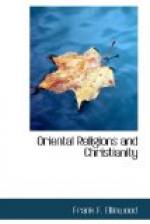[Footnote 226: Hindu Philosophy.]
[Footnote 227: The most sacred of human victims offered by the Aztecs were prepared by a month of unbridled lust. See Prescott’s Conquest.]
[Footnote 228: Nineteenth Century, July, 1888.]
[Footnote 229: Letters of Rev. Pentecost in The Christian at Work, 1891.]
[Footnote 230: The same principles are set forth with great emphasis in Isaiah, Chap. iii.]
APPENDIX
BOOKS OF REFERENCE
The books relating directly or indirectly to the wide range of topics discussed in the following lectures are too numerous for citation here; but there are some which are so essential to a thorough knowledge of comparative religion and comparative philosophy, that a special acknowledgment is due.
“The Sacred Books of the East” are indispensable to one who would catch the real spirit of the Oriental religions. The translations from Hindu, Buddhist, Mohammedan, Confucian, and Zoroastrian literatures, by Max Mueller, Rhys Davids, Oldenberg, Fausboll, Palmer, Darmesteter, Mills, Legge, Buhler, West, Beal, and other able scholars, are invaluable. The various other works of Max Mueller, “The Science of Religion,” “Chips from a German Workshop,” “The Origin and Growth of Religion,” “Physical Religion,” etc., fill an important place in all study of these subjects.
“Indian Wisdom,” by Sir Monier Williams, is the most comprehensive, and in many ways the best, of all compends of Hindu religion and philosophy. His abridged work, “Hinduism,” and the larger volume entitled “Brahmanism and Hinduism,” are also valuable. R.C. Bose has given to the public an able treatise entitled “Hindu Philosophy.” Other books on Hinduism to which more or less reference is made, are: “The Vedic Religion,” by McDonald; “India and the Indians,” by Duff; “The Life and Letters of Colbrooke;” “The Bhagavad Gita,” as translated by Chatterji; “The Vishnu Puranas,” by Wilson; “The Ramayana,” by Griffiths; “Brahmoism,” by Bose; “The Oriental Christ,” by Mozoomdar; “Christianity and Hindu Philosophy,” by Ballantyne.
Among the ablest books on Buddhism are: “Buddhism;” “The Growth of Religion as illustrated by Buddhism,” and the able article on the same subject in the “Britannica”—all by Rhys Davids. “Buddha: His Life, Character, and Order,” by Professor Oldenberg, is a scarcely less important contribution to Buddhist literature. “The Light of Asia,” by Sir Edwin Arnold, has done more than any other work to interest Western nations in the legends of Gautama; perhaps no other Oriental character has been more successfully popularized. Of the many efforts to correct the misleading impressions given by this fanciful but really poetic story, “The Light of Asia and the Light of the World,” by Dr. S.H. Kellogg, is probably the ablest. Dr. Edkins, in “Chinese Buddhism,” and Professor Beal,




